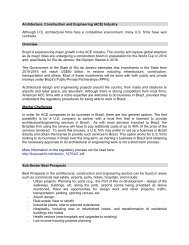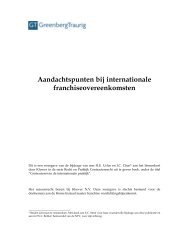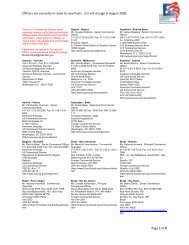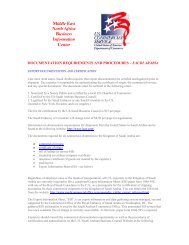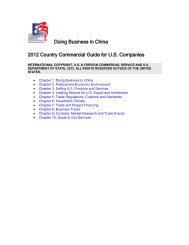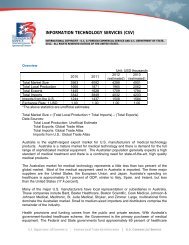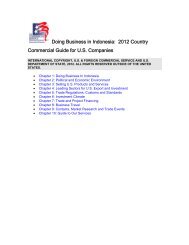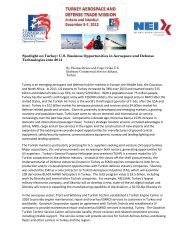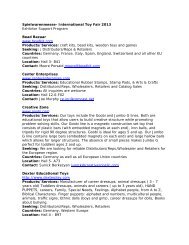Healthcare Technologies Resource Guide - Export.gov
Healthcare Technologies Resource Guide - Export.gov
Healthcare Technologies Resource Guide - Export.gov
You also want an ePaper? Increase the reach of your titles
YUMPU automatically turns print PDFs into web optimized ePapers that Google loves.
program, consisting of <strong>gov</strong>ernment-funded subsidized healthcare coverage for currently 69 diseases<br />
considered to be high-incidence. Information on the pathologies covered by this program may be found<br />
at www.fonasa.cl/wps/wcm/connect/Internet/SA-General/Asegurados/Plazos+del+Auge<br />
Market Entry<br />
U.S. medical equipment and devices are well regarded in Chile. A strategy that has proved successful for<br />
U. S. companies interested in the Chilean market is to appoint a qualified agent or distributor. Chilean<br />
distributors in the medical sector are usually knowledgeable, experienced, and with a good network of<br />
sales people throughout the country. Reliable after sales support is a priority in this market.<br />
The metric system of weights and measures is standard in Chile. The electric power supply is 220V 50Hz.<br />
Since the implementation of the U.S.-Chile Free Trade Agreement, in 2004, medical equipment, medical<br />
devices, and pharmaceuticals enter Chile duty-free, provided a U.S. certificate of origin is presented to<br />
Chilean Customs. Imports to Chile, alike all foreign and domestic products are subject to Chile’s 19% VAT<br />
(Value Added Tax).<br />
Mandatory registration at the Institute of Public Health is required for all pharmaceuticals. Medical<br />
devices such as preservatives, gloves, needles, and syringes have to be quality tested. The Ministry of<br />
Health is currently discussing imposing special requirements for medical implants in the near future.<br />
Current Market Trends<br />
U.S. state-of-the-art medical technology has good market potential in Chile, especially in the private<br />
sector that has considerable expansion projects. The Chilean private healthcare system is well regarded<br />
in the region. Private hospitals receive foreign patients for treatment on a regular basis, Some of these<br />
private hospitals have Joint Commission accreditation; therefore maintaining high standards is a<br />
permanent goal. Many Chilean physicians have U.S. post-graduate degrees and maintain regular contact<br />
with important U.S. healthcare institutions.<br />
Main Competitors<br />
The majority of the medical equipment present in the Chilean market is imported. Local statistical data<br />
shows that the United States has approximately 40% of Chile’s market share, followed by Germany<br />
with some 15%, and Japan with approximately 7% market share. Price is an extremely important factor,<br />
especially in the public sector where limited funds cover a large segment of the population. The private<br />
sector is also price sensitive, but is far more likely to consider recognized brands that have good quality<br />
and after-sales reputation.<br />
Current Demand<br />
The following list of equipment is currently on demand in Chile:<br />
• Autoclaves<br />
• Surgical tables<br />
• Non-disposable and disposable surgical<br />
instruments<br />
• Cardiology equipment including pacemakers<br />
• ECG monitors (low and medium complexity)<br />
• Ventilators<br />
• Infusion pumps<br />
• Aspiration pumps<br />
• Central monitors<br />
• Echo tomography equipment<br />
• Mobile incubators<br />
• Trauma equipment<br />
• Anesthesia instruments and appliances<br />
• Ophthalmoscopes<br />
• Hospital beds<br />
U.S. Commercial Service <strong>Healthcare</strong> <strong>Technologies</strong> <strong>Resource</strong> <strong>Guide</strong> | 2012–2013<br />
17





